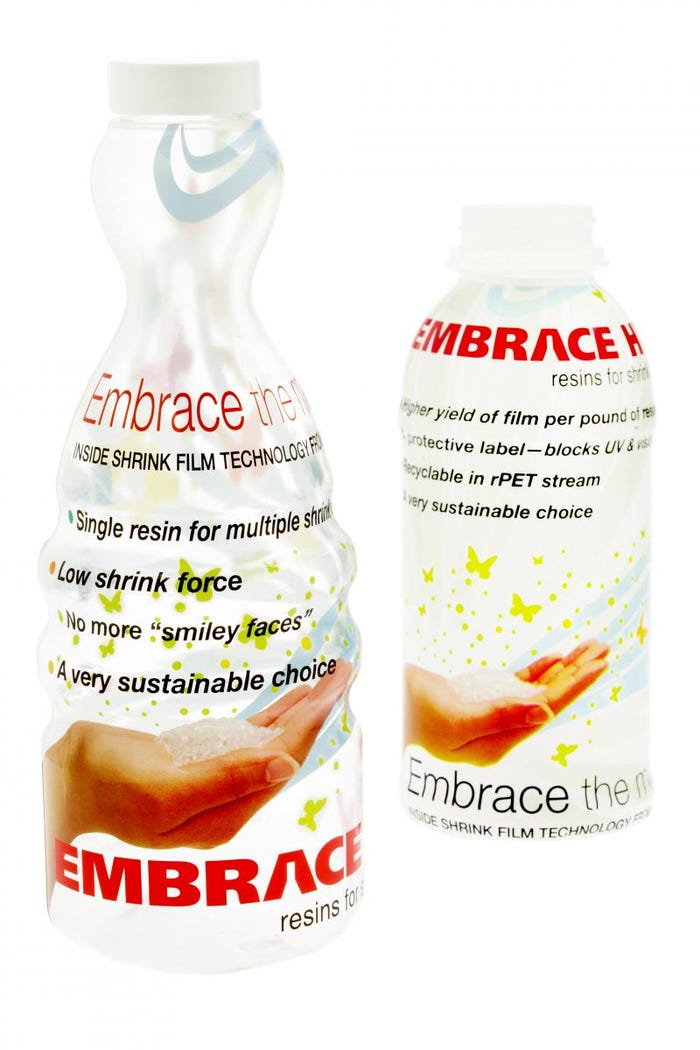Kingsport, TN—Full-body shrink sleeves are becoming more popular for non-alcoholic beverage bottles, and Eastman Chemical Co. is promoting its Embrace copolyester (PETG-based) shrink sleeves as a way for brand owners to maximize their marketing messages at the point-of-purchase. The shrink sleeves offer 360-degree graphics, allowing brand owners to reduce marketing and advertising costs while establishing a long-term emotional connection with shoppers.
August 14, 2009
Kingsport, TN—Full-body shrink sleeves are becoming more popular for non-alcoholic beverage bottles, and Eastman Chemical Co. is promoting its Embrace copolyester (PETG-based) shrink sleeves as a way for brand owners to maximize their marketing messages at the point-of-purchase. The shrink sleeves offer 360-degree graphics, allowing brand owners to reduce marketing and advertising costs while establishing a long-term emotional connection with shoppers.
“Shrink sleeves grab consumers’ attention at the shelf, when they are guaranteed to notice,” says Matt Dudas, market development manager, Embrace copolyesters for shrink films at Eastman.
Full-body shrink sleeves enable brands to use the entire surface area of the package to promote the benefits of a product and enhance shelf-impact. Through dynamic design possibilities, brand owners and retailers can quickly make a connection with consumers that will keep them buying, said Eastman.
|
Additionally, full-body shrink sleeves offer other values consumers want in packaging including eco-friendliness and hassle-free tamper evidence. What about recycling? Many shrink sleeves must be cut from the bottle or jar before recycling the package. Dudas, in a telephone interview, says that removeability issues are easy to solve.
“Brand owners can use vertical perforations down the label so it can be easily stripped off, which makes it much easier to remove than pressure sensitive labels, and there’s no glue issues to deal with,” says Dudas, adding that since 90% of the reclamation of the package is the container itself, a shrink sleeve isn’t a hindrance to recycling.
Eastman’s Embrace copolyesters provide a variety of design options and can be printed with thermocromatic, metallic and glow-in-the-dark inks and used with spot varnishing, OPV for a frosty-cold look. Eastman also produces Embrace High-Yield (Embrace HY), which has lower shrink force and delivers 20% more film per pound of standard copolyester resin, reducing overall material consumption, due to its microvoiding technology that also makes the material easier to tear for removal from the container.
“A significantly small number of new products are launched in full-body shrink sleeve labels even though some of the most successful products on the market today are packaged in shrink,” says Dudas. “Many brand owners look to shrink labels for limited-time promotional packaging, but success stories such as Method Home Products, Malibu Rum, Gatorade, and many product categories in between confirm that full-body shrink sleeves can establish and encourage long-term brand loyalty.”
According to Mintel’s Global New Products Database, for the years 2004-2008, shrink sleeves for non-alcoholic beverage containers in the U.S. is second in usage after wraparound labels. In 2004, only 83 new products came out with the shrink sleeve application. That more than doubled in 2005 to 174 new products; 219 new products were released in 2006 with shrink sleeves; 201 new products in 2007 had shrink sleeves; and in 2008, 274 new products came onto the market with shrink sleeves.
Third in new product-label applications was self-adhesive (pressure sensitive), followed by “plain” labels. Inmold labels were fifth, with no new products coming out with inmold labels in 2004 and only nine new products in 2008. That is followed by stretch sleeve and label leaflets.
“Establishing an emotional connection with consumers by offering the packaging benefits they demand is critical for making initial and repeat sales,” notes Dudas. “Shrink sleeve labels are an effective way to connect with consumers through billboard graphics and romantically contoured shapes.” —Clare Goldsberry
About the Author(s)
You May Also Like





